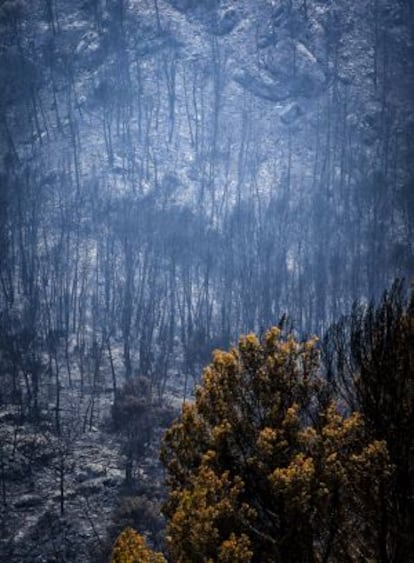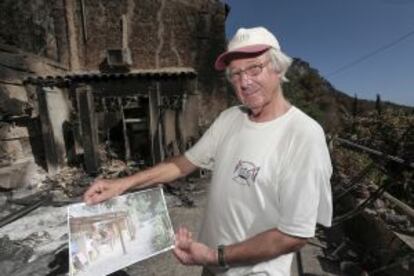Hell comes to paradise
The island of Mallorca was hit by its worst wildfire in decades in late July. EL PAÍS visited the Unesco-protected area worst affected and talked to those caught in the path of the flames

A trail of vans winds slowly along a narrow dirt track, skirting a charred valley and raising a cloud of ashes as it passes. "Kiko Paints," "Scrap iron," "Hedge trimming," read the signs printed on the vehicles. Around them is nothing but dead vegetation and burnt tree trunks, branches and undergrowth. At the end of the path, high up, lies a centenarian olive tree, of which nothing remains but the bark, whitened, cracked, like the skin of a snake. The lifeless cactus next to it looks like an octopus dragged out of a cooking pot; its tentacles flopped out on the ground. The caravan of vehicles crosses through a metal gate, and makes its way up a hill past a sign warning about guard dogs.
At the top is a darkened garden: wrinkled fruit hang from a dusty lemon tree. Out of the lovely stone house comes John Bosomworth, a 67-year-old British crime novelist who writes under the name of James Hayward Searle, a man with a cheerful demeanor who moved to the interior of Mallorca 15 years ago. Five days after the fire, with the help of the men in the vans, he's putting his life back together.
Bosomworth takes charge, and starts giving orders in a voice cracked by the dust that hangs in the air, his wife Victoria, a former police officer from Liverpool, helping translate.
He says the fire hit his property like a hurricane, burning up just about everything in the garden, including a tractor, and singeing the beams of the house. Bosomworth says the fire was upon him before he could do anything. It was midday on a typical summer's day in the Sa Coma Freda valley, a few kilometers from the town of Andratx.
On July 26, Bosomworth says he was sitting at his computer working on his latest book when he noticed a strange smell. He and his wife climbed into their four-by-four, setting off down the track that leads to the main road. After a few hundred meters a thick wall of smoke coming up the hill stopped them in their tracks. They turned round quickly and set off back to the house as fast as they could, where they warned their Russian housekeeper, gathered up their four dogs, and in two cars, tried to make their escape.
High temperatures and gusts of wind made "the perfect storm"
But they soon came up against another vehicle trying to get up the hill, away from flames towering three meters high, fed by the tinder-dry pines and a fierce wind. The heat was suffocating and they could smell the tires of their cars beginning to melt. They managed to open the gate of a neighboring property and drive through, reaching a road on the other side. But the road down to Andratx was literally melting, and they were forced to head upward toward the mountain pass and on to the small town of Estellencs.
This was the same route the fire was now traveling. "Three minutes later and we would have been goners," says Bosomworth with gallows humor. Other residents in the valley, many of them retired Germans and Britons attracted to a Mediterranean paradise that is just 15 minutes from the sea, but more secluded and cooler than down by the beach. Nobody died in the fires, but more than 2,335 hectares of land that have been classified a Unesco World Heritage Site since 2011 were destroyed in the worst blaze in the Balearics since records began in 1974.
The first alert was given at 12.30pm by the Environment Department of the Balearics regional government. By then, a thick column of smoke could already be seen from the town hall in Andratx, making its way along the bottom of the Sa Coma Calenta valley, about a kilometer away.
The temperature that day was above 30 degrees centigrade, and gusts of wind were whipping up the flames, driving them rapidly up the hillsides. "It was the perfect storm," says Estefanía Gonzalvo, a councilor in the Popular Party (PP)-controlled town hall. She immediately set off toward Sa Coma Freda, where Bosomworth was already making his escape, to raise the alarm.
Over the coming days, the town hall became the center of operations for fighting the fire, offering food and drink to the more than 400 members of the armed forces, firefighters, police, Red Cross staff, and others involved in combating the flames.

It's the Tuesday night after the blaze started and the town hall looks like one of those military control centers seen in disaster movies. There are jeeps and armored cars parked in front of the building, along with tents and trailers used as command posts. Men with their faces and clothes smeared with ash lean against walls or sit on the ground. They have been working round the clock now for four days. The fire is now "in the control phase" say fire officers. That means it's stable, but not under control. Suddenly, a shout goes up, and four men in yellow overalls leap into a "primary intervention vehicle" and tear off into the darkness. From the hills, spurts of fire can still be seen leaping into the night sky, and the air is filled with the sweet smell of burnt pine. Captain Ángel García Solaz of the local emergency services instructs us to climb aboard a Military Police four-by-four, and we head off along a closed road up toward Estellencs, the smell of smoke growing stronger by the second. It's like driving up a chimney.
The blackness is absolute, but García warns us of the danger of landslides: "in forest fires, the rocks heat up very quickly and break up. This fire spread rapidly but left some areas behind untouched: the danger now is that they will ignite." About 10 kilometers on, he stops the vehicle next to a restaurant that has been locked up. A few meters ahead is a viewing platform from where Francisco Martín, head of the rescue section of the company, is scanning the hills with his binoculars for any signs of fire.
More than 40 men are gathered here, ready to respond to any new outbreaks of fire. The night sky is clear, and the sea lies black below. Some 800 meters below the viewing platform small lights can be seen moving around. "They are damping down the ground," says Martín. After four days of fire, the flames have finally been stopped. He points out a few red points: "nothing serious, we can put them out, but it will be like this for the next two or three days, until they burn themselves out." His concern now is preventing the fire from spreading to new areas.
Martín arrived in the area on Saturday night from another blaze in Valencia; by then the fire was still two kilometers from the viewpoint. He says the steep escarpments and thick forest have made the firefighters' job harder. "The fire was incredible. We couldn't get near it. And we didn't know the landscape either. The wind was fierce, reaching 60 kilometers an hour. It could lift you off the ground, and the mix of hot air with the cooler air from the sea created mini-tornadoes that constantly changed direction."
Estellencs is about two kilometers on from the viewpoint. The firefighters assessed the situation, trying to calculate the likely speed the flames would advance at, and early on Sunday morning ordered the village's 300 inhabitants, along with a further 400 people attending a birthday party, to evacuate the area.
The trees burn right down to the roots, eventually collapsing in on themselves
"There was nothing we could do to protect the place. All we could do was wait and pray that the wind would slow and that the planes could move in to drop water from the air," says Martín. By Sunday afternoon the wind had dropped and the teams moved in, and slowly aided by cascades of water from the firefighting planes they were able to block off one of the flanks of the blaze. Seen from above, the ravaged area looks like a fang: the point of the tooth is at Andratx, and then fans out until it halts at the rock faces that hang above the sea. It's as though a bite had been taken out of the eastern end of the island.
Compared to the wildfire that devastated around 50,000 hectares in Valencia last year, the fire in Mallorca is tiny, but its impact on the island has been immense, says Joan Juan, a local environmental activist as he drives us up through the burnt-out forests. He comes to a halt at a pass from where he says he watched La Trapa go up in flames in the early hours of Sunday morning. La Trapa is an 80-hectare protected area bought in the late 1970s by the Balearics Ornithological Group, and paid for out of contributions from the public. Juan says the area had been readied against the risk of fire, "but there was nothing we could have done to protect it against this."
From here, the hillsides below look like an ash-colored carpet. From the burnt tangle of undergrowth, all that remains are a few branches, stripped bare and lying twisted like carbonized animals. The flora has been eviscerated, with just a few trunks smoldering, as though the earth itself was burning inside. Juan explains that the trees burn right down to the roots, eventually collapsing in on themselves, and leaving nothing but a hole in the ground. He lifts a stone. "See? Ants," he says, explaining that life continues, albeit underground.
The terraces constructed three decades ago along the hillsides have helped to limit the spread of the fire, but what is needed now, says Juan, is a plan to revive the area. There are one or two areas that have survived untouched. "From here, the Mediterranean forest knows how to spread," he says. A few birds flutter above. "They will help revitalize the area," says Juan with a certain air of optimism. "They spread the seeds from the green areas to the burnt land." As we look up, a fire-fighting aircraft passes by, on its way to one of the many spots still aflame in the mountains.
On Wednesday afternoon, while the planes crisscross the sky, dropping water on to the scorched land below, we visit ground zero, where the fire began. This is just behind an apartment block in Andratx, up on a steep, narrow street that comes to an end at the forest, and where a couple of small thatched houses can be found. This is where Ignacio G., the man accused of starting the fire, lives. "Poor man, he's very depressed," says one local. He has been released on bail, but nobody answers the door. A wheel barrow with the remains of a small fire sits out back, along with a water hose. Investigators say a barbecue was the cause of the fire. From here, a white mass stretches out up into the hills like a cancer. It passes within feet of the garden of a house owned by a British couple, who say they still cannot believe that they were able to keep the flames away. But nearby, Peter Bush's property was not spared. The 78-year-old is sitting in his charred garden making a list of all that was lost in the flames. He was in Britain when the fire struck, neighbors told him his house had burned down. He says that when he went online and looked at a photograph from a local paper of the head of the regional government, José Ramón Bauzá, standing in a charred garden, he recognized his property.








































